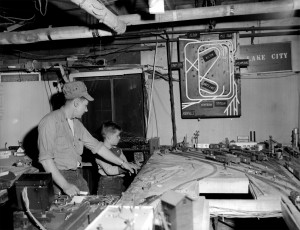RIPPLES ON THE POND, OR HOW I LEARNED SOMETHING NEW
A couple of weeks ago, Bruce Robinson, owner of the Valley Junction, asked if I would be one of the judges for his NMRA Achievement Program Model Railroad Engineer-Civil certificate. Also, he invited me to be a guest operator on the VJ.
At the end of the afternoon, several of us were just talking and, Bruce asked the group if we knew that the Caboose Industries ground throws came with a detent. What in the world is a detent?
A detent is a mechanism that temporarily keeps one part in a certain position relative to another, and can be released by applying force to one of the parts.
After I came home, I took a look at my ground throws, and sure enough, you can feel the detent as the handle is thrown to move the turnout points.
Bruce also added that Keith Shoneman has installed brads on each side of his ground throws to limit how far the handle goes. One does not have to push the ground throw handle all the way “into the dirt”.
Next, a number of 3/4 inch brads were painted Rusty Red Primer and when dry, put into place at Fort Ann. I left about 1/4 inch above ground, and the brad then acts as a stop for the handle. To me, at least, it seems to make it a lot easier to access the handle without having to dig around in the ground cover for it.
More painting of brads, and now they have been installed at several locations on the Dividing Creek. As time permits, each ground throw will have the brads added.
Thanks, Bruce and Keith.
Don Howd



